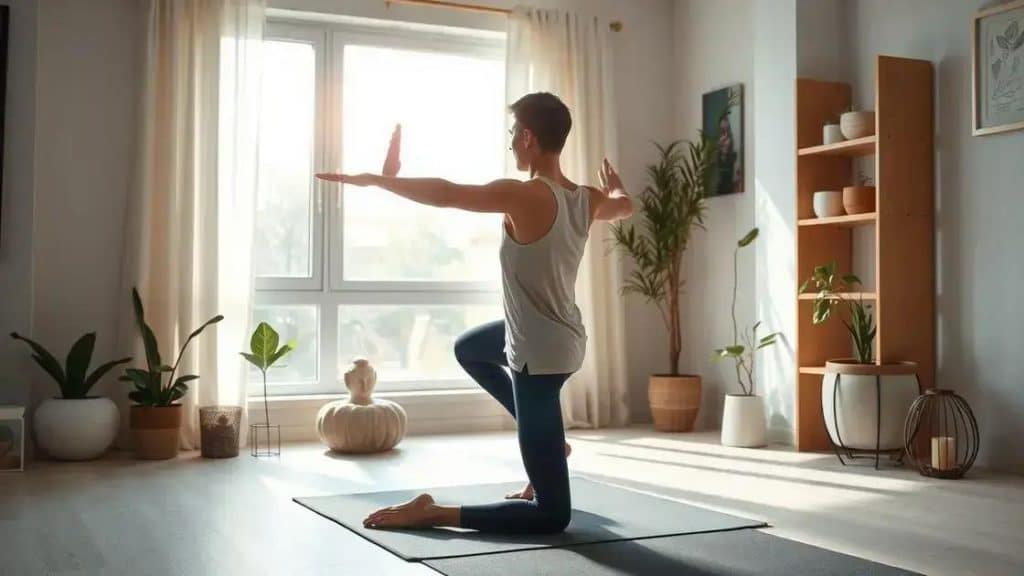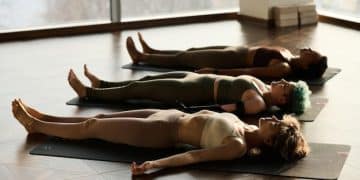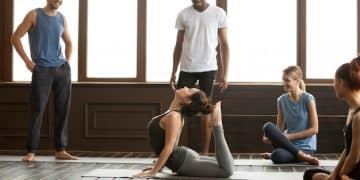Flow yoga sequences for relaxation: find your peace

Flow yoga sequences for relaxation combine movement with breath, offering essential poses like Downward Dog and Child’s Pose to enhance flexibility, reduce stress, and promote mindfulness in your practice.
Flow yoga sequences for relaxation can be a delightful way to unwind after a long day. Have you ever experienced how movement combined with breath can create a sense of calm? Let’s explore how flow can bring tranquility into your life.
What are flow yoga sequences?
Flow yoga sequences are a dynamic and engaging way to practice yoga that allows for continuous movement and breath. These sequences connect a series of poses together in a smooth, flowing manner, creating a sense of rhythm. Flow yoga emphasizes synchronization with breath, making it a perfect method for relaxation and mindfulness.
Key Elements of Flow Yoga Sequences
The essence of flow yoga is in its smooth transitions and unity with breath. Typically, practitioners move fluidly between poses, which helps to enhance mind-body connection. A well-structured flow can invigorate the body while calming the mind.
Benefits of Flow Yoga
- Improves flexibility and strength.
- Enhances mindfulness and reduces stress.
- Promotes better breathing and focus.
- Encourages a deeper connection with oneself.
As you practice flow yoga, you’ll notice how each pose naturally leads into the next. This continuous movement allows for an expressive practice that can adjust based on your mood and energy level. Engaging in these sequences frequently fosters a greater sense of peace and relaxation.
Flow yoga often includes a blend of traditional yoga poses such as Downward Dog, Warrior II, and Child’s Pose. These poses are integrated with transitions that keep your body in motion. With each breath, you can transition from one pose to another, creating a dance-like experience that feels both energizing and soothing.
It’s also important to listen to your body during flow yoga. Every individual is different, so modifying poses to suit your ability is key. Being aware of your body’s limits can help you find comfort in each pose, leading to a more fulfilling practice.
Benefits of flow yoga for relaxation

Flow yoga offers a wide range of benefits, especially when it comes to relaxation. This style of yoga combines movement with breath to create a soothing experience that calms both the mind and body. With its gentle transitions and fluid poses, flow yoga works effectively to alleviate stress and promote inner peace.
Physical Benefits
Practicing flow yoga enhances physical flexibility and strength. As you move through the various poses, your body becomes more limber. Improved flexibility can help reduce tension in the muscles, allowing for a greater range of motion. Regular practice also tones and strengthens the body, making everyday activities easier.
Emotional Well-Being
- Reduces feelings of anxiety.
- Boosts mood and promotes happiness.
- Encourages mindfulness and self-awareness.
- Fosters a deeper connection to oneself.
By focusing on breath and movement, flow yoga provides a way to step back from daily worries. The rhythmic nature of the practice helps to quiet the mind, making it easier to let go of negative thoughts. This emotional release can lead to a clearer mind and a peaceful heart.
Additionally, flow yoga encourages mindfulness. Being present in the moment can enhance your overall sense of well-being. When you concentrate on your breath, you become more attuned to your body and its needs. This awareness helps in recognizing stressors and releasing them effectively.
Another significant benefit is that flow yoga helps create a calming routine. Engaging in these sequences regularly can signal to your body that it is time to relax. This pattern reinforces a sense of safety and calm in your daily life.
Essential poses for a calming flow yoga session
To experience the full benefits of flow yoga, incorporating essential poses into your practice is key. These poses not only promote relaxation but also encourage a sense of peace and mindfulness. Here are some vital poses that can lead to a calming flow.
1. Downward Facing Dog
The Downward Facing Dog pose is a cornerstone of many flow sequences. It stretches the entire body while calming the mind. Begin on your hands and knees, then lift your hips up and back, creating an inverted V-shape.
2. Child’s Pose
Child’s Pose is perfect for relaxation. It allows the body to rest while promoting gentle stretching of the back and hips. Kneel on the floor, sit back on your heels, and extend your arms in front of you, lowering your chest to the ground.
3. Cat-Cow Stretch
The Cat-Cow stretch is great for warming up the spine. Move between these two positions smoothly, arching the back up like a cat and then dipping it down like a cow. This gentle movement also helps to synchronize breath and movement.
4. Warrior II
Warrior II builds strength and focus. Stand tall, then step back with one leg while reaching your arms out to the sides. This pose helps ground you while boosting confidence.
- Downward Facing Dog: great for full-body stretching.
- Child’s Pose: promotes calmness and relaxation.
- Cat-Cow Stretch: warms up the spine and loosens tension.
- Warrior II: strengthens the body and boosts confidence.
Integrating these poses into your flow yoga practice can create a soothing experience. Listening to your body while transitioning between these poses allows you to find your rhythm. Remember to focus on your breath, as it enhances each pose and contributes to overall relaxation.
With each flow, allow your body to lead the way. As you become more comfortable with these essential poses, you can explore new variations and movements that resonate with you. This personal touch makes your practice both enjoyable and deeply relaxing.
How to create your own flow yoga practice

Creating your own flow yoga practice can be a rewarding experience. It allows you to tailor the session to your specific needs and preferences. Start by understanding what flow yoga is: a dynamic practice that connects breath with movement.
1. Set Your Intentions
Before you begin, set clear intentions for your practice. Think about what you want to achieve: relaxation, flexibility, or strength. This will help guide your sequence. Focus on how you wish to feel by the end of your session, whether it’s calm, energized, or balanced.
2. Choose Your Poses
Select poses that resonate with you. Incorporate essential poses like Downward Dog, Child’s Pose, and Warrior II. Aim for a blend of standing and seated postures to create variety. Ensure the poses flow seamlessly from one to another for a smoother experience.
- Start with warming poses to prepare your body.
- Incorporate balance poses to enhance focus.
- Use poses that promote relaxation towards the end.
- End with restorative poses to cool down.
As you move, synchronize your breath with your movements. This connection empowers your practice, infusing each pose with intention. For example, inhale while reaching your arms overhead and exhale as you fold forward.
You can also set a time limit. Whether it’s 20 minutes or an hour, having a duration helps maintain focus and commitment. Consider using calming music or nature sounds to enhance your environment. This will create an inviting atmosphere for your practice.
Don’t forget to listen to your body. If a pose doesn’t feel right, modify it. Flow yoga is about self-exploration and adapting to your needs. Stay mindful throughout your practice, acknowledging your feelings as they arise.
By creating a personalized flow yoga practice, you’re cultivating a routine that nurtures both body and mind. Allow yourself to enjoy the journey of movement and the peace that comes with it.
FAQ – Frequently Asked Questions about Flow Yoga
What are the main benefits of flow yoga?
Flow yoga improves flexibility, builds strength, and promotes relaxation, making it an ideal practice for both body and mind.
How can I create my own flow yoga practice?
To create your own practice, set intentions, select poses that resonate with you, and focus on breathing as you move through them.
What poses should I include in my flow yoga session?
Include poses like Downward Dog, Child’s Pose, and Warrior II to create a balanced and calming flow.
How do I maintain mindfulness during my yoga practice?
Stay present by focusing on your breath and how your body feels in each pose, and adjust as needed to suit your comfort.





